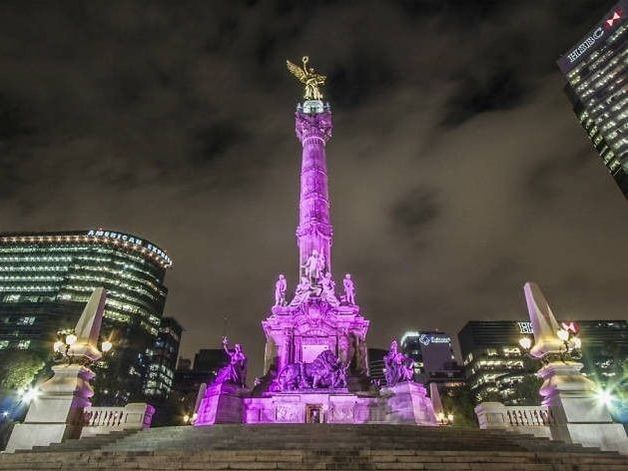Imagine yourself standing in the heart of a vibrant, bustling city, surrounded by a captivating blend of old and new. This is Mexico City, a place where centuries-old history and modern urban life intertwine seamlessly. As you explore, you’ll discover a treasure trove of landmarks that tell the city’s fascinating story.
From the ancient Aztec ruins of Templo Mayor to the modern marvels like the Museo Soumaya, Mexico City’s landmarks are as diverse as they are captivating. Each monument, building, and plaza holds a unique piece of the city’s rich history and culture. Let’s dive in and uncover the must-see landmarks that make Mexico City a true gem for travelers.
What is a famous landmark in Mexico City?
El Zócalo, the main central square in Mexico City surrounded by historic buildings like the Metropolitan Cathedral and the National Palace, is a famous landmark in the city.
What is the famous thing in Mexico City?
Mexico City is famous for its vibrant Día de los Muertos celebrations, rich Aztec and colonial history, renowned murals by artists like Diego Rivera, diverse cuisine, and lively culture.
The Unmissable Mexico City Landmarks!
Given the rich cultural tapestry that blankets Mexico City, it’s no surprise that there’s a vast array of landmarks worth visiting. According to reports by the United Nations Educational, Scientific and Cultural Organization (UNESCO), the city is home to more than 40,000 listed sites, making it an explorer’s paradise. For your excursion, it’s essential to focus on the most striking landmarks that shape the city’s identity – the Zócalo, Metropolitan Cathedral, and Palace of Fine Arts.
The Zócalo: The Heart of the City
Mexico City’s main square, the Zócalo, or Plaza de la Constitución, serves as the city’s cultural, political, and social hub. Occupying an expanse of 57,600 square meters, it’s one of the world’s largest city squares. Highlights include the mammoth Mexican flag that’s ceremonially raised and lowered daily, and its enduring pre-Hispanic era foundations. Various city events, like concerts and political rallies, take place here regularly, giving life to the sprawling space.
The Metropolitan Cathedral
The Metropolitan Cathedral, perched at the northern end of the Zócalo, is a testament to the city’s deep-rooted Catholic faith. Dating back to the 16th century, it took nearly 250 years to complete, resulting in an eclectic mix of architectural styles ranging from Gothic to Baroque. Inside, visitors marvel at the golden Altar of the Kings and the hanging Chapel of the Christ of Poison.
Bellas Artes Palace
The Palace of Beautiful Arts, known as Bellas Artes Palace, stakes its claim as one of the city’s most visually impressive landmarks. This stunning marble edifice hosts a variety of cultural events in its striking Art Nouveau and Art Deco halls. Art enthusiasts can relish the works of renowned Mexican artists like Diego Rivera and Rufino Tamayo, whose murals adorn the walls of this emblematic cultural site. Lastly, the Bellas Artes Palace, famed for its breathtaking glass curtain, created by Tiffany & Co., remains a stalwart symbol in Mexico City’s landscape.
Digging into the Past: Pre-Hispanic Landmarks
Following your journey through Mexico City’s top landmarks, it’s time to delve deeper into its pre-Hispanic heritage. The age-old structures not only provide insights into its rich culture but reflect the ancient societies that once thrived here.
The Teotihuacan Pyramids
The Teotihuacan Pyramids, located northeast of downtown Mexico City, represent a pivotal archaeological site reflecting the grandeur of pre-Hispanic civilizations. Archaeologists estimate these pyramids were erected around 100 BC, making them some of Mexico’s oldest structures. Playing vital roles in ancient rituals, they remain sites of celebration during the Spring equinox, when the sun aligns with the monuments.
The Templo Mayor
Moving into the heart of Mexico City, you’ll find the Templo Mayor. This historic site, discovered in 1978, served as the main temple to the Aztec god Huitzilopochtli. Beneath its layers exists a time capsule, showcasing the Aztec civilization at its peak during the 14th and 15th centuries. Furnished with stone carvings, architectural ruins, and turquoise mosaics, this archaeological site presents a chronicle of Aztec philosophy and culture.
The National Museum of Anthropology
Lastly, no tour of Mexico City’s pre-Hispanic landmarks can skip a visit to the National Museum of Anthropology. Housing the world’s largest collection of ancient American art, it holds artifacts from distinct Mesoamerican civilizations. Exhibiting everything from Maya stone carvings to Aztec calendars, it offers a comprehensive trip through Mexico’s vibrant and complex pre-Hispanic history.
Throughout your explorations, take a moment to marvel at the continuity of cultures and the intricate tapestries of stories each landmark weaves. Immerse yourself in Mexico City’s past as you explore these historical landmarks that silently testify to its rich heritage. Keep these sites in mind, seizing every opportunity to deepen your understanding of Mexico’s historically complex and culturally rich past.
Landmarks of Modern Mexico City
Building on its culturally rich past, Mexico City’s modern landmarks meld tradition with contemporary vibes, offering visitors an insight into an evolving cityscape rooted in deep history.
Soumaya Museum
The Soumaya Museum, designed by acclaimed architect Fernando Romero, houses one of Latin America’s most extensive art collections. Inspired by Rodin sculptures, the museum’s reflective metallic exterior mirrors the evolving metropolis it inhabits, making it a key part of Mexico City’s modern skyline.
Inside, over 66,000 pieces spanning 30 centuries await your exploration. Here, you’ll find works from legendary artists like Salvador Dalí, Auguste Rodin, and Rufino Tamayo – a testament to Mexico’s enduring embrace of global art. The museum’s free admission policy aids in democratizing art appreciation, reiterating the city’s commitment to cultural dissemination.
Angel of Independence Monument
Rising above the bustling Paseo de la Reforma, the Angel of Independence Monument stands as a testament of Mexico City’s evolution. Built in 1910 to commemorate Mexico’s 100 years of independence, the gilded masterpiece has since grown beyond its initial intent, becoming a rallying point for political protests and celebratory events alike.
Crowned by a bronze statue bearing a laurel wreath and a broken chain, the monument embodies liberation and self-determination, resonating with the spirit of modern Mexico City. Venture up the internal staircase, and a stunning panoramic view of Mexico City rewards your effort, providing a unique perspective into a metropolis continually rewriting its narratives while firmly grounded in its proud past.
Green Spaces in Mexico City
Going beyond the manmade marvels, Mexico City also boasts several green spaces that serve as landmarks in their own right. They offer an oasis amidst urban hustle, allowing you a glimpse of the city’s rich biodiversity and commitment to sustainability.
Chapultepec Park
The Chapultepec Park, spanning over 1,695 acres, holds the status of one of the largest city parks in the Western Hemisphere. Serving as the city’s lungs, the park beautifully breaks up the urban expanse with its lush greenery, tranquil lakes, and zoo. It houses several museums, including the renowned National Museum of Anthropology. Additionally, it’s home to Chapultepec Castle – which was a military academy, imperial home, and presidential residence in different eras – testifying to the city’s layered history. With its number and diversity of attractions, Chapultepec Park becomes more than a park; it’s a slice of Mexico City itself.
Viveros de Coyoacán
Smaller, yet equally compelling, Viveros de Coyoacán serves as another green gem in Mexico City. This tree nursery turned park exhibits a range of exotic and native plants, offering a serene site for nature lovers and gardening enthusiasts. Its well-paved paths attract fitness enthusiasts for a morning jog or an evening stroll. The tranquil environment, coupled with the chirping of birds, provides a welcome escape from the city’s noisy streets. Interesting to know, Viveros de Coyoacán is linked with historical significance as it was founded by Miguel Angel de Quevedo, known as the ‘Apostle of the Tree,’ contributing to the city’s ecological preservation.
Mexico City Landmarks by Night
Mexico City’s nocturnal sights offer unique experiences, combining cultural extravaganza with breathtaking views. Transforming into a vibrant hub as the sun sets, the city dishes out unprecedented nighttime adventures at its iconic landmarks.
Lucha Libre at Arena Mexico
Dive into an encounter unlike any other at Arena Mexico, the mecca of Lucha Libre. Held every Tuesday, Friday, and Sunday, these wrestling matches showcase masked luchadores engrossed in passionate combat, captivating the audiences with acrobatic feats. Picture masked fighters, the crowd cheery and seated on the edge, rooting for their favorites. The charged atmosphere, added to the high-flying moves of the luchadores, makes for an unforgettable spectacle. Although famed for its day tours, at night, Arena Mexico truly transforms itself into an emblem of Mexico City’s cultural identity.
Nighttime Views from Torre Latino
Rising higher than any other building in the city, Torre Latino offers unparalleled night views of Mexico City. At an impressive 44 stories tall, it’s among the city’s most iconic structures. You’re greeted by unobstructed city skylines, with panoramas that stretch far into the horizon. High-speed elevators transport you to the observation deck where a 360-degree view of the cityscape awaits. Behold the city lights twinkling beneath the starry sky, reflecting off the metropolis, offering an enchanting spectacle for anyone willing to venture up. When night descends over Mexico City, a visit to Torre Latino is an absolute must to truly appreciate the city’s skyline.
In Mexico City, nightfall signifies not an end to the day, but the beginning of an unforgettable journey. Its nightlife complements the beauty and history of the landmarks seen throughout the day. Mexico City beckons you to explore her iconic landmarks under the romance of the starlit sky.
Culinary Landmarks in Mexico City
Having experienced Mexico City’s cultural and modern-day landmarks, immerse yourself further into Mexico City’s unique identity by exploring the culinary landmarks. It offers overwhelming sensory experiences at its traditional markets – Mercados, and the luxury of dining at globally recognized gourmet destinations like Pujol and Quintonil.
Traditional Markets in Mexico City (Mercados)
Engage your senses and explore Mexico City’s traditional Mercados. Playing a significant role in community life, these markets serve as a treasure trove for authentic Mexican flavor, vibrant visuals, and bustling everyday life.
Among the various Mercados, Mercado de San Juan Pugibet and Mercado de la Nueva Viga stand out as culinary landmarks. San Juan Pugibet, based in a neighborhood dating from Aztec times, showcases regional produce and a variety of unusual meats, including crocodile and lion. The Nueva Viga market, famed as one of the world’s largest fish markets, displays marine life ranging from the Gulf of Mexico to the coasts of Alaska. Immerse yourself, taste the local dishes, and experience the dazzling array of scents, sights, and sounds these Mercados bring to life.
Gourmet Destinations: Pujol and Quintonil
Progress from traditional markets to upscale dining experiences by visiting Pujol and Quintonil, two Michelin level restaurants boasting a world-class gastronomic journey.
Pujol, led by acclaimed chef Enrique Olvera, consistently ranks in the world’s top 50 restaurants list. Its experimental menu combines pre-Hispanic and contemporary techniques, creating a unique tasting experience. One noteworthy dish, “Mole Madre,” matured over 1,700 days, extends traditional culinary practices.
Quintonil, run by Chef Jorge Vallejo, also finds its place in the world restaurant rankings. Quintonil highlights the freshness and purity of Mexican ingredients and delivers an earth-to-table experience. Its standout dish ‘Nopal Cactus’ exemplifies this ethos.
Drawing from Mexico City’s rich culinary traditions, these gourmet destinations offer discerning diners delectable dishes that deliver a sense of Mexico’s vast gastronomical landscape.

